Most of the Great Lakes surface has frozen for the second consecutive winter.
Nearly 81% of the lakes’ surface area was covered with ice, the NOAA Great Lakes Environmental Research Laboratory reported on February 20.
That was down slightly from more than 85% on February 19.
Temperatures have plunged this month, nearly doubling over the past couple of weeks.
Records show the lakes’ most widespread freeze was 94.7% in 1979. The ice cover topped out at 92.2% in March 2014.
The ice blanket reaches across more than 90% of Lakes Superior, Huron and Erie, while Lakes Michigan and Ontario are more than halfway covered.
It has produced some spectacular visual images, from ice caves along the Lake Michigan shoreline to a glacial buildup making it appear that Niagara Falls had frozen in place.
[youtube kATDIqgnsp8 650]
According to US scientists, 2014 was the warmest year on record, with global temperatures 0.68C (1.24F) above the long-term average.
The results mean that 14 of the 15 warmest years on record have occurred since the turn of the century.
NASA and NOAA researchers published the report on January 16.
Last month, the World Meteorological Organization released provisional figures that predicted the past 12 months were set to be record breakers.
“This is the latest in a series of warm years, in a series of warm decades,” said Gavin Schmidt, director of NASA’s Goddard Institute for Space Studies.
“While the ranking of individual years can be affected by chaotic weather patterns, the long-term trends are attributable to drivers of climate change that right now are dominated by human emissions of greenhouse gases,” he added.
NASA and the US National Oceanic and Atmospheric Administration (NOAA) maintain two of the three global datasets of global temperatures. The UK’s Met Office maintains the third. Data from all three are used by the World Meteorological Organization (WMO) and formed the basis of its provisional figures in December.
Reviewing extreme weather during 2014, the WMO highlighted a number of record-breaking events:
- In September, parts of the Balkans received more than double the average monthly rainfall and parts of Turkey were hit by four times the average.
- The town of Guelmin in Morocco was swamped by more than a year’s rain in just four days.
- Western Japan saw the heaviest August rain since records began.
- Parts of the western US endured persistent drought, as did parts of China and Central and South America.
- Tropical storms, on the other hand, totaled 72 which is less than the average of 89 judged by 1981-2010 figures. The North Atlantic, western North Pacific and northern Indian Ocean were among regions seeing slightly below-average cyclone activity. [youtube SstUwTtk6iQ 650]


